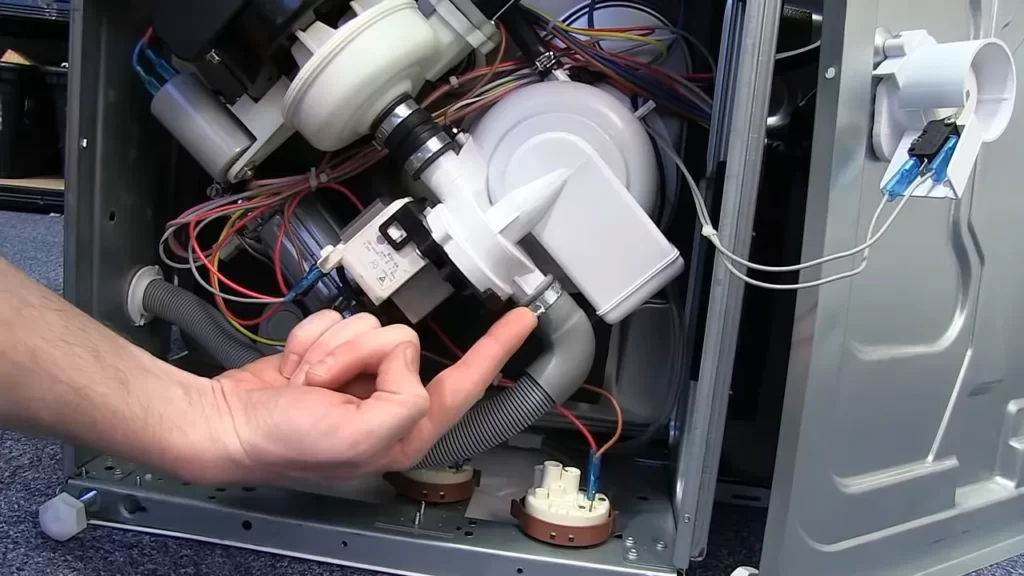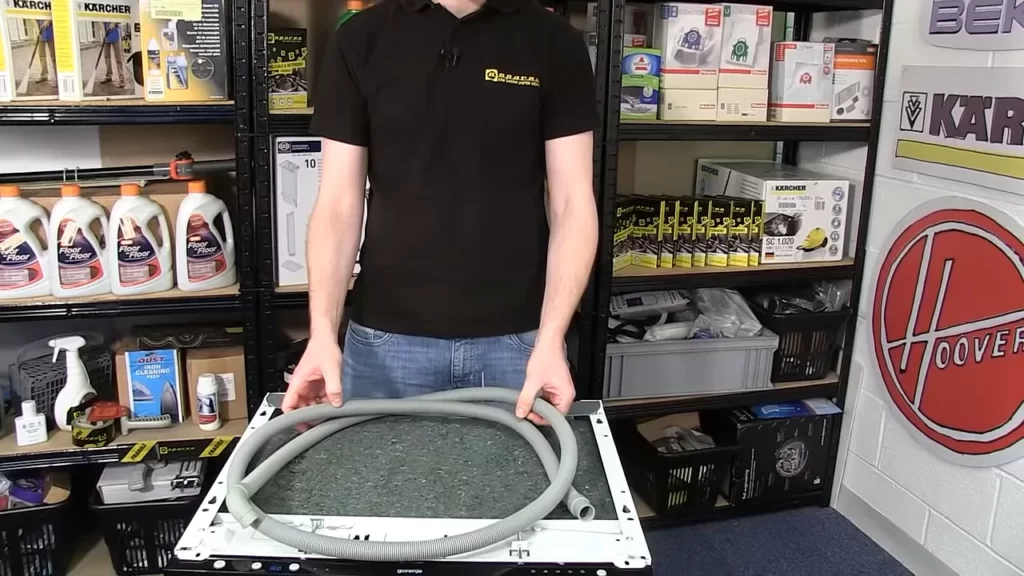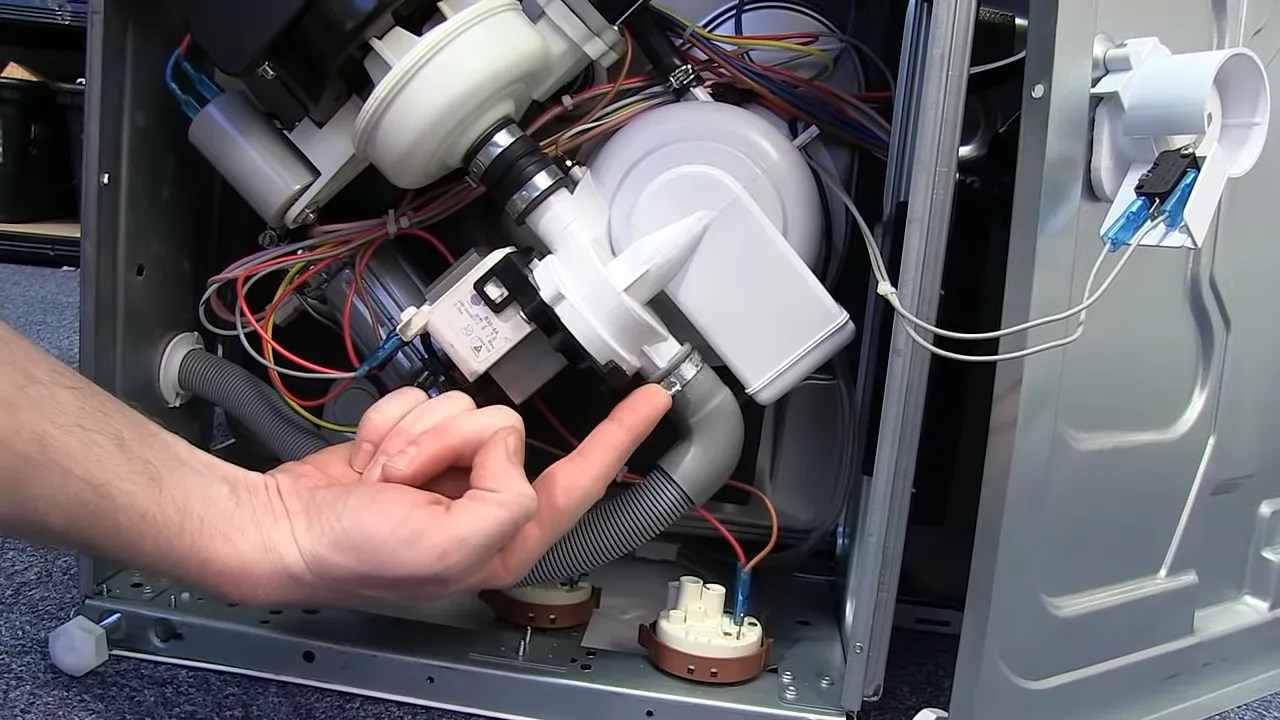To install a dishwasher drain hose, first, locate the drain inlet on the back of the dishwasher and connect the hose to it securely using a hose clamp. Then, route the other end of the hose to the sink’s drainpipe or garbage disposal unit, ensuring a proper and secure connection.
Gathering The Required Tools And Materials
What tools and materials are needed for installation?
Gathering the required tools and materials is an important first step when installing a dishwasher drain hose. By having everything you need on hand, you can ensure a smooth and efficient installation process. Here are the essential tools and materials you’ll need:
- Adjustable wrench
- Screwdriver (Phillips and flathead)
- Utility knife
- Bucket or towel
- Measuring tape
- Gloves and safety goggles
- Level
- Teflon tape
- New dishwasher drain hose
- Drain hose clamp or zip tie
- Owner’s manual of the dishwasher (for reference)
Where to purchase the required items?
When it comes to purchasing the required tools and materials, there are a few options available. You can find them at your local home improvement stores, such as Home Depot or Lowe’s. These stores usually have a wide range of plumbing supplies and tools to choose from. Additionally, you can also check online retailers like Amazon, where you can conveniently browse and order the items you need. Be sure to compare prices and read customer reviews to ensure you’re getting high-quality products that meet your specific requirements.
Tips for choosing the right drain hose for the dishwasher
Choosing the right drain hose for your dishwasher is crucial to ensure proper functionality and prevent any leaks or drainage issues. Here are a few tips to help you make an informed decision:
- Measure the length needed: Start by measuring the distance between your dishwasher’s drain outlet and the sink drain or disposal. This will give you an accurate idea of the length required for the drain hose.
- Material quality: Look for a drain hose made of high-quality materials, such as durable plastic or rubber. It should be flexible yet sturdy enough to withstand regular use and potential pressure changes.
- Diameter compatibility: Check the diameter of your dishwasher’s drain outlet before purchasing a drain hose. Ensure that the hose’s diameter matches or is compatible with the outlet’s size. This will ensure a snug fit and prevent any leakage.
- Consider anti-kinking features: Some drain hoses come with anti-kinking features, such as braided designs or reinforced construction. These features can help prevent bends or kinks in the hose, ensuring smooth water flow.
- Consult the owner’s manual: The owner’s manual of your dishwasher may provide specific guidelines or recommendations regarding compatible drain hoses. Consulting it can help you choose the right hose that meets the manufacturer’s requirements.
By following these tips, you can select an appropriate drain hose that suits your dishwasher’s needs and ensures efficient drainage without any issues.

Step-By-Step Installation Process
Installing a dishwasher drain hose may seem like a daunting task, but with the right guidance, you can do it yourself. Follow the step-by-step instructions below to ensure a smooth and successful installation process.
Preparation: Turning off the power and water supply
Before you begin the installation process, it’s essential to turn off the power and water supply to your dishwasher. This step ensures your safety and prevents any damage to the appliance or your home. Locate the power switch or circuit breaker dedicated to the dishwasher and switch it off. Next, find the water shut-off valve and turn it clockwise until it’s fully closed.
Removing the existing drain hose: Where to locate it and how to detach it
Now that you’ve prepared the dishwasher for installation, it’s time to remove the existing drain hose. The drain hose is usually located at the back of the dishwasher. Check for any clamps or fasteners that may be securing it to the appliance or the drain pipe. Use a screwdriver or pliers to loosen and detach these clamps. Once the clamps are removed, gently pull the drain hose away from the dishwasher and drain pipe.
Measuring and cutting: Determining the length of the new drain hose and cutting it to fit
With the old drain hose removed, it’s time to measure and cut the new one. Measure the distance from the dishwasher’s outlet to the drain pipe, ensuring that you have enough length for a comfortable connection. Mark the measured length on the new drain hose. Using a sharp utility knife or hose cutter, carefully cut the hose to the desired length. Ensure that the cut is clean and straight to ensure a proper fit.
Connecting the drain hose: Attaching the new hose to the dishwasher and the drain pipe
Now that you have the right-sized hose, it’s time to connect it to your dishwasher and the drain pipe. Start by sliding one end of the new drain hose onto the dishwasher’s outlet. Make sure it fits snugly and securely. Next, position the other end of the hose over the drain pipe and push it in until it’s firmly in place. Check for any leaks or loose connections and adjust if necessary.
Securing the connections: Using clamps or zip ties to ensure tight and leak-free connections
Now that the drain hose is connected, it’s crucial to secure the connections to prevent leaks. Use clamps or zip ties specifically designed for securing hoses to tighten the connections between the dishwasher outlet and the drain pipe. Ensure that the clamps or zip ties are tight enough to hold the hose securely without damaging it. These secure connections will prevent any potential leaks during the dishwasher’s operation.
Checking for leaks: Running a test cycle to ensure proper drainage and leak-free installation
With the connections secured, it’s time to check for leaks before completing the installation process. To do this, carefully turn on the water supply and the power to your dishwasher. Run a test cycle and observe the drainage process. Keep an eye out for any leaks from the connections or any signs of water pooling or dripping. If you notice any leaks, tighten the connections further or adjust the hose as needed until the installation becomes leak-free.
Adjusting the hose if necessary: Troubleshooting common issues and making adjustments
If you encounter any issues during the test cycle, such as poor drainage or leaks, you may need to troubleshoot and make adjustments to the hose. Check for any kinks or bends that may be obstructing the flow of water. The hose should be positioned in a way that allows for gravity-assisted drainage. If necessary, make adjustments, ensuring the hose is free from any obstructions and properly aligned with the dishwasher outlet and drain pipe.
Once you have completed these steps, you can confidently say that you have successfully installed a dishwasher drain hose. Following this step-by-step installation process ensures proper functionality and avoids any potential leaks or drainage issues.

Tips And Troubleshooting
Ensuring proper alignment and positioning of the drain hose
One of the key factors in ensuring the smooth functioning of your dishwasher drain hose is to make sure it is properly aligned and positioned. This will help to prevent leaks and blockages, and ensure that the wastewater is properly drained away.
When installing the drain hose, it is important to check that it is not twisted or kinked. A twisted or kinked drain hose can restrict the flow of water and lead to blockages. To avoid this, carefully unroll the drain hose and ensure that it is straight without any bends or kinks.
You should also make sure that the drain hose is securely connected to both the dishwasher and the sink drain. Use hose clamps or zip ties to secure the connections and prevent any leaks.
Avoiding kinks and bends that can cause blockages
Kinks and bends in the dishwasher drain hose can cause blockages and prevent the wastewater from properly draining out of the dishwasher. To avoid this, it is important to maintain a straight and smooth path for the drain hose.
Make sure that the drain hose is not bent or crimped in any way. Avoid placing heavy objects on the hose or positioning it in a way that could cause it to bend or kink.
Dealing with clogs and backups in the dishwasher drain hose
If you are experiencing clogs or backups in your dishwasher drain hose, there are a few steps you can take to try and resolve the issue.
First, check for any visible blockages in the drain hose. Use a flashlight to inspect the hose and remove any debris or buildup that may be blocking the flow of water.
If the blockage is not easily visible or accessible, you can try using a plumber’s snake or a wire hanger to break up the clog. Insert the snake or wire hanger into the drain hose and gently maneuver it back and forth to dislodge the blockage.
Preventing foul odors and stagnant water in the dishwasher drain
Foul odors and stagnant water in the dishwasher drain can be unpleasant and indicate a problem with the drain system. To prevent this, it is important to keep the drain hose clean and free from debris.
Regularly inspect the drain hose for any buildup or blockages and clean it as necessary. You can use a mixture of warm water and vinegar to flush out any dirt and debris. Additionally, running a hot water cycle with a dishwasher cleaner can help to eliminate any odors and bacteria that may be present in the drain hose.
Maintaining and cleaning the drain hose for optimal performance
To ensure optimal performance of your dishwasher drain hose, regular maintenance and cleaning are essential.
Regularly check the drain hose for any signs of wear or damage. If you notice any cracks or leaks, it is important to replace the hose immediately to prevent further issues.
Cleaning the drain hose regularly will help to prevent blockages and keep the water flowing freely. You can use a mixture of warm water and dish soap to clean the hose, or a dishwasher cleaner specifically designed for this purpose.
Frequently Asked Questions
How Should A Dishwasher Drain Hose Be Installed?
To install a dishwasher drain hose, follow these steps: 1. Locate the drain connection on your dishwasher. 2. Attach the drain hose securely to the drain outlet. 3. Ensure the hose is not kinked or twisted. 4. Position the other end of the hose into the drainpipe or garbage disposal.
5. Use a hose clamp to secure the hose in place. Remember to consult your dishwasher’s manual for specific instructions.
Does A Dishwasher Drain Hose Need A Loop?
Yes, a dishwasher drain hose needs a loop. The loop prevents backflow of dirty water into the dishwasher.
Where Do You Cut Hole For Dishwasher Drain Hose?
You should cut a hole for the dishwasher drain hose near the sink or garbage disposal. Avoid any obstructions and make sure it is securely attached for proper drainage.
How To Install A Washer Drain Hose?
To install a washer drain hose, follow these steps: 1. Locate the drain outlet on the washer. 2. Attach one end of the hose to the outlet and tighten it securely. 3. Find a suitable drain pipe or standpipe near the washer.
4. Connect the other end of the hose to the drain pipe or standpipe. 5. Make sure the hose is secure and doesn’t leak. Test it by running a cycle.
Conclusion
Installing a dishwasher drain hose may seem like a daunting task, but by following the step-by-step guide provided in this blog post, you can easily accomplish it. Remember to carefully read the manufacturer’s instructions and ensure that you have all the necessary tools before starting the installation process.
By properly installing the drain hose, you can avoid any potential leaks or blockages, ensuring your dishwasher functions efficiently. So, go ahead and confidently tackle the installation process yourself. Your dishwasher will be up and running smoothly in no time!
